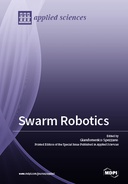Explore

Collectively working robot teams can solve a problem more efficiently than a single robot, while also providing robustness and flexibility to the group. Swarm robotics model is a key component of a cooperative algorithm that controls the behaviors and interactions of all individuals. The robots in the swarm should have some basic functions, such as sensing, communicating, and monitoring, and satisfy the following properties:
This book is included in DOAB.
Why read this book? Have your say.
You must be logged in to comment.
Rights Information
Are you the author or publisher of this work? If so, you can claim it as yours by registering as an Unglue.it rights holder.Downloads
This work has been downloaded 284 times via unglue.it ebook links.
- 216 - pdf (CC BY-NC-ND) at Unglue.it.
Keywords
- 3D model identification
- artificial bee colony algorithm
- artificial flora (AF) algorithm
- asymmetrical interaction
- autonomous docking
- behaviors
- bionic intelligent algorithm
- Comparison
- congestion control
- consensus control
- cooperative target hunting
- coordinate motion
- Cramer–Rao low bound (CRLB)
- environmental perception
- event-driven coverage
- event-triggered communication
- fish swarm optimization
- Formation
- formation control
- formation reconfiguration
- genetic algorithm
- improved potential field
- meta-heuristic
- Mobile robots
- modular robots
- multi-agents
- multi-AUV
- multi-robot system
- multiple robots
- n/a
- nonlinear disturbance observer
- obstacle avoidance
- optimal configuration
- optimization
- panoramic view
- parallel technique
- particle swarm optimization
- path optimization
- Patterns
- robotics
- scale-invariant feature transform
- search
- search algorithm
- self-assembly robots
- self-organization
- sensor deployment
- shape normalization
- signal source localization
- sliding mode controller
- surface-water environment
- surveillance
- swarm behavior
- Swarm Chemistry
- Swarm intelligence
- Swarm intelligence algorithm
- swarm robotics
- system stability
- target recognition
- time-difference-of-arrival (TDOA)
- UAV swarms
- underwater environment
- unmanned aerial vehicle
- virtual linkage
- virtual structure
- weighted implicit shape representation
Links
DOI: 10.3390/books978-3-03897-923-4Editions


